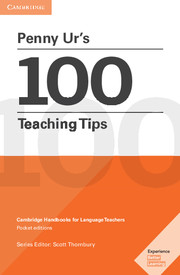Book contents
- Frontmatter
- Contents
- Why I Wrote this Book
- Beginning and Ending the Lesson
- The Coursebook
- Discipline
- Error Correction
- Games
- Grammar
- Group Work
- Heterogeneous (Mixed-Level) Classes
- Homework
- Interest
- Listening
- Pronunciation
- Reading Comprehension
- Speaking Activities
- Teacher Talk
- Testing and Assessment
- Vocabulary Teaching
- Writing
- P.S.
- Index
- Photo Acknowledgements
Error Correction
Published online by Cambridge University Press: 17 November 2023
- Frontmatter
- Contents
- Why I Wrote this Book
- Beginning and Ending the Lesson
- The Coursebook
- Discipline
- Error Correction
- Games
- Grammar
- Group Work
- Heterogeneous (Mixed-Level) Classes
- Homework
- Interest
- Listening
- Pronunciation
- Reading Comprehension
- Speaking Activities
- Teacher Talk
- Testing and Assessment
- Vocabulary Teaching
- Writing
- P.S.
- Index
- Photo Acknowledgements
Summary
This is a controversial topic, but on the whole the consensus today is that error correction helps learning. There are, however, occasional situations where we might prefer not to correct; and there are different ways of doing so, some more effective than others.
17 Do correct mistakes
18 Correct (sometimes) during speech
19 Get students to self-correct
20 Draw attention to right answers
17 Do correct mistakes
In most cases, if you’re wondering whether you should or should not correct a mistake: do!
There's quite a lot of convincing research evidence that error correction helps learning (see the overview referred to below). And most learners, if you ask them, will tell you that they want you to correct their mistakes in both speech and writing.
I remember running an interactive journal project with my students during which they recorded their entries, then I listened and recorded my responses. At the beginning, I didn't correct mistakes on the basis that what was important was the message, not the accuracy. After the first round, one of the students came and asked me to tell her if there were any mistakes in her speech in my recorded responses. I agreed, and asked if there was anyone else who also wanted me to do so. The response was a unanimous ‘Yes, please!’.
This doesn't mean that you should correct every single error. There are situations where just getting the message across is the priority, and you don't need to worry about mistakes. And certainly you should not expect each correction to result in complete eradication of the mistake forever! But making mistakes and having them corrected is one major avenue through which we learn; and it should be related to as such. So if a student makes a mistake, try to treat it not as a failure, but as a learning opportunity. For example: ‘Did you notice that you said ‘‘He a boy’’? … You need to remember to put in is: He is a boy’ – rather than: ‘You got that wrong, you should have said…’.
18 Correct (sometimes) during speech
You may have been advised never to interrupt students to correct when they’re in the middle of speaking in a communication activity. But there are times when you can – and should.
It's true that correcting a student in the middle of their speech may be inappropriate.
- Type
- Chapter
- Information
- Penny Ur's 100 Teaching TipsCambridge Handbooks for Language Teachers, pp. 20 - 24Publisher: Cambridge University PressPrint publication year: 2016



